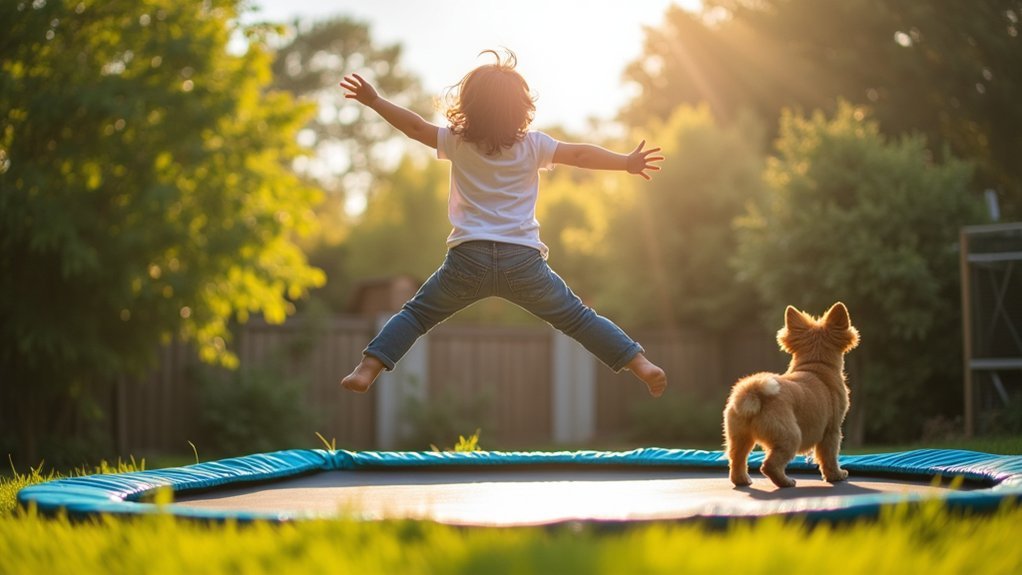Trampoline training offers a powerful method to strengthen your vestibular system through controlled bouncing movements. You’ll improve balance, spatial awareness, and reduce dizziness by stimulating the inner ear’s semicircular canals and otolith organs. Start with seated exercises on mini trampolines before progressing to standing bounces, head movements, and eventually more complex patterns. Aim for three short daily sessions to promote adaptation. The following guide reveals how to design an 8-week progressive program for maximum benefits.
List of 12 Second-Level Headings

The following twelve headings form the backbone of your vestibular training program, providing a thorough approach to balance development.
These sections will guide you through an all-encompassing trampoline-based vestibular training system:
- Understanding Your Vestibular System
- Setting Up a Safe Trampoline Environment
- Basic Bouncing Techniques for Beginners
- Progressive Movement Patterns
- Integrating Proprioception and Balance
- Advanced Vestibular Challenges
- Adapting Exercises for Different Ages
- Measuring Vestibular Improvement
- Combining Visual and Vestibular Training
- Managing Sensory Overload During Training
- Creating a Consistent Practice Schedule
- Therapeutic Applications for Special Needs
Each section builds upon the previous, helping you develop stronger vestibular function through proper trampoline use.
You’ll learn techniques that therapists use while having fun in the process.
Regular bouncing provides straight line vestibular stimulation that significantly benefits balance and spatial orientation development.
The Science Behind Vestibular Stimulation
While many people associate the vestibular system simply with balance, its functions extend far beyond keeping you upright. Located in your inner ear, this sophisticated system includes semicircular canals and otolith organs that detect both rotational and linear movements of your head.
When you stimulate your vestibular system, you’re actually triggering a cascade of neurological responses. Your brain processes these signals, influencing your autonomic nervous system—affecting heart rate, blood pressure, and even emotional responses. The vestibulo-ocular reflex produces eye movements in the opposite direction to head movement, helping maintain visual stability during activity.
This stimulation activates both sympathetic and parasympathetic pathways, releasing neurotransmitters that regulate your body’s functions.
The beauty of vestibular training lies in its adaptability. Your brain can recalibrate its sensitivity through consistent practice, improving spatial orientation and proprioception.
Your brain’s remarkable ability to recalibrate vestibular sensitivity creates pathways for enhanced spatial awareness through dedicated practice.
This neuroplasticity means you can actually train your vestibular system to become more efficient over time.
Why Trampolines Provide Optimal Neural Feedback

Trampolines stand out as exceptional tools for neural feedback because they create a unique combination of instability and rebound that constantly challenges your vestibular system. Each jump triggers proprioceptive input, enhancing your awareness of body position while stimulating vestibular responses that improve spatial orientation.
The activity simultaneously engages multiple sensory pathways, facilitating integration for those with processing difficulties. You’ll experience increased dopamine release during sessions, boosting both cognitive function and motivation while reducing stress and anxiety. This activity is particularly beneficial for those experiencing mental health conditions like anxiety, providing a therapeutic outlet for emotional regulation.
What makes trampolines truly ideal is their all-encompassing approach to neural development. You’re building strength and coordination while receiving resistive input that benefits muscle health.
For individuals with special needs, trampolines offer therapeutic benefits by organizing the nervous system and providing calming effects that improve attention and reduce defensiveness.
Getting Started: Essential Equipment for Safe Rebounding
When setting up your rebounding equipment, you’ll need to choose between mini trampolines that fit indoors and full-size models that offer greater jumping freedom.
Safety enclosures are non-negotiable features that prevent falls and injuries, especially for beginners or those with balance challenges.
Your selection should match your available space, training goals, and current vestibular system capacity, with mini trampolines being ideal for controlled therapeutic exercises while full-size options better accommodate dynamic movement patterns. Consider incorporating a balance pad beneath or near your trampoline to provide a safe transition surface and allow for complementary stability exercises.
Safety Enclosures Matter
Safety defines the foundation of any effective vestibular training program, especially when it comes to rebounding. Trampoline enclosures aren’t optional—they’re vital for preventing falls, which account for most trampoline injuries.
When selecting an enclosure, look for high-density polyethylene mesh that’s both durable and weather-resistant. Quality netting slows your momentum if you lose balance, reducing impact force. Features like secure zipper closures provide easy access while maintaining protection.
Beyond fall prevention, enclosures shield you from wind and debris while offering important UV protection. Despite their introduction in 1997, trampoline enclosures have shown no measurable decline in falling-off injuries, which still represent over 27% of all trampoline-related emergency department visits. They’re particularly important for families, giving parents peace of mind while children develop their vestibular systems through active play.
Mini vs. Full-Size
Choosing between mini and full-size trampolines represents one of your first essential decisions when starting vestibular training through rebounding.
Mini trampolines (36-48 inches) offer space efficiency, affordability, and indoor versatility—perfect if you’re just beginning vestibular exercises or have limited space. Models like the JumpSport 300 PRO Series are specially designed for fitness and balance training with enhanced durability.
Full-size options (starting at 6 feet) provide superior bounce quality and consistency, especially rectangular models that deliver even rebounding across the surface. This enhanced bounce creates more effective vestibular stimulation through higher jumps and more dynamic movement sequences.
While both carry similar injury patterns, mini versions typically result in less severe incidents.
Your budget matters too—mini trampolines cost considerably less while premium full-size models offer better durability with warranties up to 10 years.
Consider your space, training goals, and long-term commitment when deciding.
Beginner Protocols for Vestibular Adaptation

Three foundational principles guide effective vestibular rehabilitation for beginners.
First, start with basic exercises in a seated position where you’re safest. Practice simple eye movements (up-down, side-to-side) before progressing to head movements and gentle body shifts. Aim to perform these exercises three times daily as consistency helps your brain adapt to abnormal stimuli.
Second, guarantee safety at all times. Stay near supportive surfaces and consider working with a physiotherapist who can customize exercises to your needs. Remember that mild dizziness during exercises is normal but severe symptoms signal you should pause.
Third, build consistency. Regular practice is vital for vestibular adaptation. Gradually increase difficulty as your tolerance improves, shifting from seated to standing exercises.
This progression builds confidence while enhancing gaze stability and balance, ultimately reducing vertigo episodes and improving your daily activities.
Advanced Techniques for Seasoned Jumpers
Once you’ve mastered basic jumping techniques, you’ll need to incorporate rotational movements that challenge your vestibular system in all planes.
You can enhance adaptation by cross-training different sensory pathways simultaneously, such as combining trampoline exercises with laser alignment tasks or balance exercises. Consider adding gaze stabilization exercises while on the trampoline to improve vision and focus during movement.
Optimizing your recovery time between sessions will maximize neural integration and prevent vestibular system fatigue.
Rotational Movement Progression
As experienced jumpers progress beyond basic maneuvers, mastering advanced rotational movements demands systematic training that challenges your vestibular system’s limits.
Begin with controlled reversals like backdrop pullovers before advancing to somersaults, training your body to maintain orientation while upside-down without relying on head movement.
- Practice the essential falling-backward drill while standing still, initiating rotation with your toes while maintaining trampoline contact to develop spatial awareness.
- Increase rotational speed by tucking limbs closer to your core, reducing moment of inertia and combining with visual spotting techniques.
- Progress methodically from single rotations to complex combinations like Half-In Half-Out, incrementally incorporating quarter turns before advancing to half and full twists. Building a strong foundation in basic skills before attempting these advanced movements is crucial for safety and proper technique development.
Always use safety mats and proper spotting techniques during this progression.
Cross-Training Sensory Pathways
Seasoned jumpers seeking to elevate their vestibular training beyond basic rotational movements must integrate multiple sensory pathways simultaneously.
Your trampoline routine should intentionally combine vestibular and proprioceptive inputs to maximize sensory processing benefits.
Try alternating between different jump heights while maintaining spatial awareness of your surroundings. This challenges your vestibular system to adapt quickly to changing gravitational forces. The rhythmic bouncing involved in these exercises provides emotional regulation support that can help manage stress and anxiety while strengthening neural pathways.
Add multidirectional movements—forward jumps followed by lateral shifts or diagonal patterns—to enhance your brain’s ability to process complex spatial information.
For maximum cross-training effect, incorporate timing challenges that require precise coordination. Jump to specific rhythms or perform sequences that demand executive function engagement.
Your nervous system thrives on this integrated approach, strengthening neural connections between sensory systems and improving your overall balance, coordination, and spatial orientation.
Recovery Time Optimization
Advanced jumpers who excel at cross-training sensory pathways often overlook a key component of vestibular training: strategic recovery periods.
To maximize your vestibular development, you’ll need to optimize your recovery time between sessions.
- Frequency and Duration – Schedule 2-3 trampoline sessions weekly, each lasting 20-30 minutes, with rest intervals to prevent overexertion while promoting adaptation.
- Progressive Complexity – Gradually increase exercise difficulty by incorporating movement patterns like spins and turns, allowing your vestibular system time to adjust to new challenges.
- HIIT Integration – Alternate between high-intensity jumping exercises and recovery periods, enhancing your vestibular system’s resilience while preventing fatigue that could lead to diminished returns.
Your vestibular system, like any neurological pathway, requires adequate recovery time to strengthen and adapt properly. The straight-line movements experienced during trampoline exercise directly stimulate the vestibular system, improving balance and spatial orientation awareness.
Measuring Progress: Balance Assessment Tools
When training your vestibular system, reliable tools to measure your progress become essential for tracking improvements and identifying areas that need work. Common assessment methods include Videonystagmography (VNG), which uses infrared goggles to track eye movements, and the Dynamic Visual Acuity Test to evaluate vision during head movements.
Effective vestibular training relies on measurement tools to track progress and pinpoint areas requiring focused attention.
For thorough evaluation, consider Computerized Dynamic Posturography using force plates to assess your stability. The Clinical Test of Sensory Integration and Balance offers a four-phase vestibular assessment, while the Berg Balance Scale evaluates your functional mobility through 14 practical tasks. Some clinical settings utilize Orion rotary chairs to detect bilateral vestibular losses with exceptional precision.
Advanced options like the Video Head Impulse Test (vHIT) can precisely measure your vestibulo-ocular reflex function.
Regular assessments using these tools help customize your training program and track rehabilitation progress objectively over time.
Combining Visual Tracking With Bouncing Exercises
Combining your trampoline bouncing with eye exercises can dramatically improve your vestibular system’s functionality.
You’ll strengthen your ability to maintain stable vision while moving by focusing on fixed points during bounces, while simultaneously expanding your peripheral awareness through targeted tracking activities.
These combined exercises provide excellent oculomotor practice, helping your eyes and inner ear communicate more effectively during dynamic movements. Maintaining soft knees during these visual tracking exercises ensures your body remains properly aligned to absorb impact safely while optimizing lymphatic circulation.
Stabilizing Gaze During Bounces
The simultaneous challenge of maintaining visual focus while your body experiences vertical motion forms the foundation of vestibular-visual integration training. As you bounce, your brain must coordinate signals from your eyes and inner ear, strengthening neural pathways essential for balance and spatial awareness.
Begin with prone positioning on the trampoline while a partner creates gentle motion, then progress to seated bouncing before attempting standing jumps. Target tracking drills become particularly effective once you’ve mastered basic stability. Using the recommended JumpSport Fitness Trampoline can provide the optimal stability needed for these exercises due to its curved leg design.
- Try fixing your gaze on a wall decal while bouncing to train your vestibulo-ocular reflex.
- Practice tossing and catching a ball mid-bounce to enhance eye-tracking abilities.
- Incorporate dual-task challenges like reciting the alphabet while maintaining visual focus on a target.
Peripheral Vision Enhancement
Beyond the center of your visual field lies an expansive perceptual territory that greatly impacts your balance and spatial awareness. Trampoline exercises uniquely train this peripheral vision system through consistent motion challenges.
While bouncing, practice “object sweep exercises” by maintaining central gaze while tracking items in your peripheral zones. Alternate between focusing on central targets and lateral markers mid-jump to develop directional awareness. Use high-visibility markers at vision field edges to improve contrast sensitivity, particularly helpful for low-light conditions.
Incorporate 360° awareness drills with full-range head turns during jumps to expand your functional visual field. This exercise is especially effective because it engages both central and peripheral vision simultaneously for enhanced visual clarity. As you bounce, intentionally note movement in your outer visual fields during ascents and descents. This strengthens neural pathways between eye movements and your vestibular system, enhancing overall spatial orientation.
Oculomotor Control Practice
Your vestibular system thrives when visual tracking merges with dynamic bouncing exercises on a trampoline. This powerful combination strengthens the neural pathways connecting your visual and vestibular systems, enhancing your brain’s ability to process movement and spatial orientation simultaneously. Regular practice can lead to long-lasting effects on your overall vestibular function and sensory integration.
- Try “Trampoline Ball Catch” – bounce steadily while tossing and catching a ball, gradually increasing height and speed as your tracking improves.
- Practice “Target Touch” – place colorful targets around your trampoline at various heights and touch them in sequence while maintaining your bounce rhythm.
- Incorporate “Scanning Jumps” – while bouncing, quickly shift your gaze between multiple objects placed around the trampoline, challenging your eyes to adapt to motion.
These exercises improve cognitive integration, balance, and neurological development while making vestibular training enjoyable and engaging.
Proprioceptive Integration During Rebound Sessions
While bouncing on rebounding surfaces, your body simultaneously engages multiple sensory systems in a coordinated dance of awareness. Each jump activates proprioceptors in your joints and muscles, creating precise spatial feedback that synchronizes with your vestibular system. Integrating trampolines into therapy sessions provides significant proprioceptive input that supports sensory processing goals.
| Technique | Benefit | Implementation |
|---|---|---|
| Vertical jumps | Regulates sensitive vestibular systems | Start with 2-3″ bounces |
| Side-to-side hops | Improves lateral balance | Use non-slip mats |
| Seated bounces | Isolates core proprioception | Add compression wear |
| Single-leg jumps | Intensifies per-limb feedback | Incorporate spotter rails |
| Gaze stabilization | Integrates visual mapping | Focus on distant point |
Try incorporating pause intervals between jumps to prevent sensory overload. The impact forces from each bounce trigger important Golgi tendon organ activation, refining your body’s force modulation abilities and enhancing overall movement coordination.
Case Studies: Real Results From Trampoline Therapy
Although research specifically focused on trampoline therapy for vestibular rehabilitation remains limited, emerging evidence suggests promising outcomes for patients with balance disorders.
While most documented cases involve traditional vestibular rehabilitation methods, clinicians are increasingly incorporating trampoline exercises into extensive treatment plans. You’ll find that these adaptations often yield improvements in daily functioning and quality of life. However, it is important to recognize that trampolining can lead to permanent injuries if not properly supervised.
- Balance Recovery – Patients report significant reductions in dizziness and improved stability after supervised trampoline sessions that gradually increase in complexity.
- Confidence Building – Many users experience enhanced psychological comfort during daily activities that previously triggered vestibular symptoms.
- Functional Independence – Integrating trampoline work with standard protocols helps patients regain independence in challenging environments like crowded spaces.
Addressing Common Challenges and Setbacks
Despite the benefits of vestibular training on trampolines, many practitioners encounter significant obstacles when implementing these therapeutic approaches.
Fear of heights commonly affects individuals with vestibular processing difficulties, requiring gradual exposure and consistent physical support during initial sessions.
When you’re working with clients experiencing dizziness or nausea, start with gentle, rhythmic movements and incorporate regular breaks.
These symptoms typically decrease as the vestibular system adapts, but pushing too hard too quickly can reinforce avoidance behaviors.
For those who avoid motion-based activities altogether, begin with low-impact exercises on stable surfaces before shifting to the trampoline.
Combine vestibular input with proprioceptive activities to enhance integration and create a more thorough sensory experience.
Trampolining aids in developing postural control by challenging the body to constantly adjust to changing positions while maintaining balance during bouncing activities.
Always tailor your approach to individual tolerance levels, prioritizing positive experiences over intensity.
Designing a Progressive 8-Week Training Program
Now that we’ve addressed common challenges, let’s build a structured approach to vestibular training. Our 8-week trampoline program gradually increases intensity while building your vestibular function, balance, and coordination systematically.
1. Weeks 1-2: Begin with gentle bouncing, walking patterns, and basic balance poses to acclimate your system while incorporating visual tracking exercises. The bellicon’s bungee suspension system provides the ideal platform for these foundational exercises, enhancing balance with every bounce you take.
2. Weeks 3-6: Progress to varying bounce heights, rotational movements, and one-legged balance challenges.
You’ll integrate rhythmic music for auditory-vestibular connection and eventually attempt eyes-closed exercises.
3. Weeks 7-8: Master complex movement sequences, multi-directional bounces, and focal tasks like catching objects while jumping.
You’ll shift to balance boards for advanced training, consolidating your new skills through consistent practice.
Frequently Asked Questions
Can Trampoline Therapy Help With Specific Vestibular Disorders Like BPPV?
While trampoline therapy provides vestibular stimulation, there’s limited research on its effectiveness for BPPV specifically. You’ll need medical supervision as trampolining might trigger symptoms rather than relieve them in some cases.
How Does Trampoline Training Differ From Other Vestibular Rehabilitation Techniques?
Unlike traditional vestibular rehabilitation’s static exercises, you’ll find trampoline training offers dynamic movement, continuous sensory feedback, and higher engagement. It’s more active and fun while still providing effective proprioceptive and vestibular stimulation.
Are There Age-Related Modifications Needed for Seniors Using Trampolines?
Yes, you’ll need lower-intensity bouncing, handlebar support for balance, seated exercises for limited mobility, soft-surface trampolines to protect joints, and shorter sessions (10-15 minutes) with gradual progression as you adapt.
Can Trampoline Therapy Help Manage Motion Sickness or Travel-Related Vertigo?
Trampoline therapy may help manage your motion sickness and travel vertigo by strengthening your vestibular system. You’ll build sensory integration skills through controlled jumping, though results vary and it’s best combined with other treatments.
How Do Weather Conditions Affect Outdoor Trampoline Vestibular Training Effectiveness?
Weather considerably impacts your outdoor vestibular training. Rain makes trampolines slippery and dangerous, wind destabilizes equipment, extreme temperatures affect material elasticity, and poor conditions can reduce your motivation and consistency in training sessions.
In Summary
You’ve now learned how trampolines can revolutionize your vestibular training. By committing to consistent rebounding sessions, you’ll strengthen neural pathways that enhance your balance, spatial awareness, and coordination. Don’t hesitate to adapt exercises to your comfort level as you progress. Your vestibular system responds remarkably to this specialized training—you’ll soon notice improvements that extend far beyond the trampoline into everyday movements and activities.





Leave a Reply